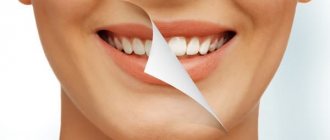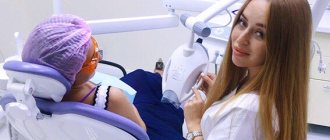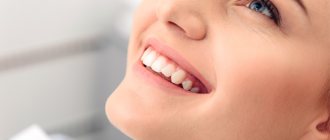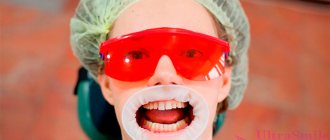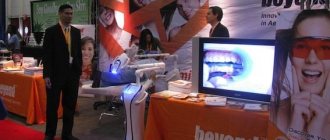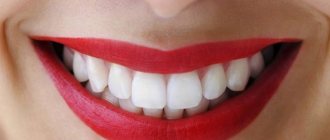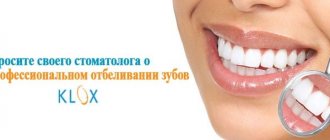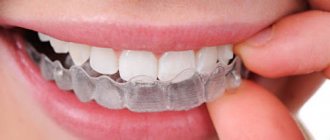In modern society, one correct and definitely useful trend has emerged - to pay close attention to the condition of your teeth. People strive to get the perfect Hollywood smile with straight white teeth, realizing that such a smile is not only an aesthetic appearance of the face, but also an opportunity to successfully build different relationships - personal and business. Teeth whitening is one of the services of modern dentistry that helps a person acquire an ideal smile.
For teeth whitening in a clinic (professional whitening), different technologies are used, and one of them is ZOOM 4. We will talk to you about the Zoom 4 teeth whitening method in this article: after reading the material, you will get acquainted with the features of Zoom 4, find out the indications and contraindications to this type of in-office whitening, the stages of whitening will also be discussed and a review will be provided in which Zoom 4 is compared with other methods of professional teeth whitening. We will not ignore the issue of price for the ZOOM 4 whitening service in Moscow.
Professional teeth whitening ZOOM 4: general information
The ZOOM 4 professional teeth whitening technology was developed in the USA and quickly became popular and in demand among dentists and patients all over the world; Moscow dental clinics also offer the ZOOM 4 tooth enamel lightening service to their patients.
When using ZOOM 4, lightening of tooth enamel is achieved through the action of a special preparation that is used to treat tooth surfaces. This drug contains hydrogen peroxide in high concentration (25%), which can destroy pigmented particles that cause darkening of natural tooth enamel. A substance such as calcium phosphate is also present in the whitening gel formula. It does not help in whitening, but it does help maintain the integrity of tooth enamel and strengthen it.
After application to the teeth, the gel does not immediately begin to work for whitening - it must be activated with the cold light of an LED lamp. Under light exposure, the drug begins to disintegrate and during this reaction, the process of releasing oxygen atoms occurs, penetrating deep into the enamel and dentin and dissolving pigments.
Teeth whitening ZOOM 4 uses specialized lamps produced by the Philips brand - Philips Zoom White Speed. These lamps have three operating modes, each of which provides its own power. This allows the dentist to select the strength of light exposure on dental surfaces individually for each patient and thus make ZOOM 4 teeth whitening not only effective, but also safe.
Application of silicone mouth guards
The teeth whitening procedure using silicone aligners deserves special attention. This process is carried out in several stages:
- The dentist takes an impression of the oral cavity.
- Production of individual silicone trays in the laboratory.
- Filling the tray with a special gel. Unlike concentrated professional products, gels with low acid concentration are used at home.
- The patient uses a prepared structure according to a special scheme. The mouthguard is worn every day, following the instructions and gradually increasing the wearing time.
- At the end of the treatment session, the oral cavity is cleaned of any remaining gel and rinsed thoroughly.
The condition of the tooth enamel will become noticeably better within a week after starting to wear the mouth guard, but to get a snow-white smile, a course lasting 25–30 days is required.
Indications for teeth whitening ZOOM 4
Any dental procedure has indications for implementation, teeth whitening ZOOM 4 is no exception in this regard. Zoom 4 will be the most effective and useful procedure for you under the following circumstances:
- The enamel of your teeth has darkened due to drinking tea, coffee, smoking, and frequent consumption of coloring foods;
- With age-related darkening of tooth enamel;
- ZOOM 4 whitening can be used by people suffering from fluorosis, a disease that causes spots and streaks to appear on the enamel of teeth;
- When the enamel darkens due to long-term treatment with drugs of the tetracycline group.
NOTE: In the article we will provide photos before and after ZOOM 4 whitening, but you should understand that your result may differ from the examples given, since the degree of teeth whitening for each person is individual and it also depends on the initial state of the enamel, its natural shade, depth of dentin colored with pigments.
Zoom whitening: contraindications
There is a list of absolute and relative contraindications to professional whitening. Absolute contraindications mean “under no circumstances,” and relative contraindications are possible, but only after eliminating the negative factor/situation in the patient’s health condition
1) List of absolute contraindications –
- oncological diseases,
- diabetes,
- age up to 18 years,
- pregnancy and lactation period,
- increased sensitivity to ultraviolet radiation,
- taking certain medications that cause increased tissue sensitivity to ultraviolet radiation (see list of medications below).
Name of drugs by INN (international non-proprietary names): Ciprofloxacin, Chlorthiazide, Chlopthalidone, Demodocylin, Nabumetone, Hydrochlorothiazide, Norfloxacin, Ofloxacin, Naprosyn, Oxaprozin, Sparfloxacin, Piroxicam, Tetracyclin, Psoralens, Sulindac, Doxycydine.
2) List of relative contraindications –
- with inflammation of the gums,
- in the presence of untreated caries,
- in the presence of deep wedge-shaped defects with exposure of dentin,
- if you have fillings, crowns or veneers on your front teeth*
*You should note that chemical whitening only affects the tooth structure, but cannot change the color of crowns, veneers and fillings that may be on the front teeth. Therefore, if you are not going to spend money on replacing fillings and crowns, you should not do whitening, because... you will get a sharp contrast between the whitened tooth tissue and the fillings and crowns of the previous shade.
When is it better to stop using ZOOM 4 teeth whitening?
ZOOM 4 whitening is recognized by experts as a gentle technique that does not lead to destruction of dental tissue and enamel, but in some cases, if there are certain contraindications, it cannot be performed.
These contraindications to ZOOM 4 whitening include:
- A large number of fixed dentures and large fillings in the oral cavity. The fact is that the ZOOM 4 whitening procedure can only make natural tooth enamel whiter, but crowns and fillings will not become lighter from photo-whitening;
NOTE: Can ZOOM 4 whitening be used to lighten fillings? This question is often heard on various dental forums on the Internet. However, the answer to this will be negative - no whitening technique can make either fillings or dentures lighter. If you want ideal whiteness of teeth on which there are fillings, it is better to choose another technique used in aesthetic dentistry - installing veneers. Another possible option is to replace old fillings with new restorations after bleaching.
- Teeth whitening ZOOM 4 is not carried out during the period of bite correction with braces and for six months after its completion;
- Zoom 4 is contraindicated for use during pregnancy and lactation;
- Teeth whitening is not performed on children and teenagers. The procedure is contraindicated for young patients because the process of teeth formation is still ongoing until the age of 18; teeth whitening during this period can do more harm than good;
- ZOOM 4 is contraindicated in the presence of cancer, mental disorders, or abnormally high sensitivity of teeth.
Before whitening, it is necessary to cure teeth affected by caries, eliminate gum inflammation, and remove accumulated plaque and tartar from the surfaces of teeth. If this is not done, the effectiveness and usefulness of ZOOM 4 will be reduced to zero.
NOTE: ZOOM 4 does an excellent job of removing pigmented plaque caused by smoking. However, if after Zoom 4 whitening a person continues to smoke and does it often, the positive effect of the procedure will be extremely short-lived!
How does light affect the effectiveness of whitening?
Not all, but many professional teeth whitening systems recommend using light during the procedure, and Zoom is no exception. For many years, there has been debate in the dental community about whether light activation actually speeds up and improves the teeth whitening process. So why do we need light here at all?
According to the technology, the light flux activates a chemical photocatalyst in the whitening gel, which helps break down hydrogen peroxide into active components (free radicals). This increases the concentration of active radicals that simultaneously act on tooth tissue, which in theory should increase the strength of whitening. Most scientific publications on this topic are not independent, and are financed by the manufacturers of such systems themselves.
But there are also several independent studies that use the most objective approach to assessing results, called “split arch”. Using this method, each patient's teeth are divided into halves: on the left half of the jaws the same type of whitening is performed with light, and on the right half - without light. Next, the results are compared. This method is the gold standard for evaluating whitening methods because... here different methods are compared on the teeth of one person, and not on different people (whose teeth may respond differently to whitening).
List of scientific studies (showing that the use of light does not affect the effectiveness of whitening) –
- Hein 2003 This study used the split-arch method to evaluate the effectiveness of 3 professional bleach systems (LumaArch, Optilux 500 and Zoom !) - with and without the use of bleach light. Conclusion: Additional use of light did not whiten teeth any better than simply using a whitening gel.
- CRA 2003 This clinical study also used the split arch method to study 7 professional whitening systems - LaserSmile, LumaArch, Niveous, Opalescence Xtra Boost, PolaOffice, Rembrandt and Zoom ! Conclusion: Using the whitening light did not improve the whitening process compared to using only the whitening gel included in the kits for these systems.
- Kugel 2006 Conclusions: A clinical study using the split arch method showed that the results of light-activated whitening were slightly better, but only initially. When the subjects' teeth were re-evaluated 2 weeks after treatment, no differences were found where the whitening light was used and where it was not.
→ Example of a clinical study (about the ineffectiveness of light in teeth whitening).
Then why do dentists recommend light whitening?
It's all about marketing. Using a light lamp during whitening adds a “glamour” to the procedure, making the whitening process more impressive. And this impression of something special tends to attract consumers and help stimulate demand for such a service. In turn, home whitening systems do not offer additional light exposure, although they are no less effective.
Thus, whitening lamps allow you to solve 2 problems at once. Firstly, they motivate patients to choose professional rather than home whitening systems (because in the eyes of patients they look more convincing). Secondly, this allows you to sell a professional whitening service costing from 15,000 to 20,000 rubles - much more expensive than whitening systems for home use, which cost about 3,500-5,000 rubles.
That's the whole secret. In addition, companies producing whitening systems now make money not only from kits with whitening gel, but also from sales of whitening lamps to dental clinics. Therefore, it is natural that manufacturers of foaming mouth whitening systems will claim that their light lamp is an important part of the whitening process. For example, the cost of a Zoom WhiteSpeed lamp will cost a clinic approximately 180,000 rubles, which is naturally passed on to the patients.
Benefits of professional teeth whitening ZOOM 4
The ZOOM 4 teeth whitening technique has a number of advantages that have made it popular among patients in Moscow and other cities of our country.
These benefits include:
- Whitening is safe, no harm to tooth enamel. ZOOM 4 is recognized as a gentle technology for lightening tooth enamel, since it uses a gel with a reduced content of aggressive substances, and the doctor can control and select the strength of light radiation;
- When whitening ZOOM 4, burns to the soft tissues of the mouth and overheating of the pulp - the nerve of the tooth - are excluded;
- The gel used in the procedure contains not only an active bleaching agent, but also calcium phosphate, which strengthens and restores enamel;
- The procedure is carried out quite quickly - in just one hour, and during this time you can achieve enamel whitening - by 5-7 tones;
- If you follow all the dentist’s recommendations after teeth whitening ZOOM 4, the effect of the aesthetic procedure will last for a long time - up to 5 years.
Among the disadvantages of the ZOOM 4 method, we can only mention the fairly high price for the service in Moscow. But all the costs of the procedure are fully compensated by its safety and effectiveness.
NOTE: The ZOOM 4 teeth whitening service is offered by many clinics in Moscow. However, it is important to know that this procedure will only be truly safe and effective if it is performed by an experienced and qualified specialist. The slightest mistakes by a doctor or inaccurate adherence to ZOOM 4 technology can cause a variety of negative consequences - increased sensitivity of teeth, burns of soft tissues of the oral cavity. Therefore, if you are planning to undergo the Zoom 4 teeth whitening procedure in Moscow, choose a clinic carefully!
Types of teeth whitening in dentistry
- Laser. Using a laser, you can lighten tooth enamel to a color pre-selected by your doctor.
- Chemical. Chemical whitening involves the use of special pastes with a pronounced abrasive effect.
- Mechanical. Lightening by brushing teeth. For this, different methods are used: ultrasound, toothpaste, pharmaceutical preparations based on activated carbon, powders, etc. This method helps if dark plaque on the enamel appears from frequent consumption of caffeine-containing drinks, smoking, or after wearing braces for a long time.
- Endobleaching. The method consists of cleaning the mouths of the root canals from the old filling and applying a whitening gel to the coronal part. It is used for teeth with removed roots and filled root canals, as well as in cases where several external lightening procedures have failed.
- Photobleaching. A special gel containing hydrogen peroxide is applied to the enamel. This gel is then shined with a halogen lamp, which releases active oxygen, which pushes pigments out of the tooth and discolors them. From time to time the procedure has to be repeated.
Professional teeth cleaning
It is also possible to make teeth whiter after hygiene procedures: removal of tartar, supra- and subgingival deposits, etc. After professional teeth cleaning, the teeth will become noticeably lighter. However, you will not whiten your teeth, you will only return them the natural color that was lost due to the abuse of coloring products or smoking.
I would like to pay special attention to such a popular procedure as AirFlow , which is actively positioned as a whitening procedure. In fact, talking about this method as a teeth whitening system is incorrect. During professional cleaning with AirFlow, the tooth surface is treated with a mixture of water, air and sodium bicarbonate particles (in other words, soda), which is supplied from a special nozzle under pressure and at high speed. In this case, plaque and bacterial films are removed, the enamel is polished and better reflects light. But there is no chemical effect on the teeth. In fact, after any professional preventive measure, teeth become cleaner and, of course, lighter.
Ultrasonic teeth cleaning is also often marketed as a teeth whitening method. And this is also wrong. The essence of this procedure is that hard plaque is removed from teeth under the influence of electric current without damaging the enamel. At the end of the procedure, a special paste is applied to the teeth. There is also no chemical effect on the teeth.
Summary: if you regularly visit the dentist and carry out preventive measures (removal of plaque, tartar, supra- and subgingival deposits), then your teeth will remain clean and natural white . How satisfied you are with the natural color of your teeth is a matter of individual perception. In any case, hygiene measures and regular visits to the dental hygienist should be included in your list of aesthetic procedures. This is the most cost-effective way to keep your teeth healthy and white. And remember that if you decide to whiten your teeth (be it at-home teeth whitening or in-office techniques), you will in any case have to go through the entire range of hygiene procedures.
Teeth after whitening
Within 2-4 hours after any procedure, it is not recommended to consume food and drinks containing coloring components. This is especially true for coffee, strong tea and smoking. It is advisable to get rid of the smoking habit forever, as it not only stains the enamel, but also destroys its structure.
Any method has a negative effect on the enamel; tooth sensitivity increases after whitening. To restore it, it is recommended to engage in remineralization therapy. It is necessary to use pastes with a high concentration of fluoride and calcium. When eating, increase your consumption of dairy products and fish. Temporarily avoid sour vegetables and fruits.
For high sensitivity, use sensitive pastes. For the best effect, it is recommended to combine them with fluoride-containing rinses. This effect is carried out for 2-3 months.
Whitening is not a completely safe procedure for teeth. Before deciding on any method, it is worth consulting with an experienced dentist and, possibly, strengthening the enamel before all teeth lightening procedures.
Safe home remedies
You can make your smile naturally white and beautiful at home. To do this, you need to carefully monitor your oral health, brush your teeth at least twice a day, rinse your mouth every time after eating, use floss and an irrigator, and also visit the dentist twice a year for preventive maintenance. But if you want to make your enamel even whiter, you can turn to home whitening methods for help. You just need to use them very carefully, after assessing the condition of the enamel by a dentist and taking into account his recommendations. Now let’s look at effective and safe ways to whiten at home.
Kits – gel and mouth guard
In any case, first you will have to visit a dentist so that he can conduct a diagnosis and give a professional assessment of the current condition of the enamel. As a home whitening method, you may be offered to take a course using a special gel and tray. First, the doctor must take impressions of the jaws. Based on them, an individual mouthguard will be created that will fit as tightly as possible to the teeth to guarantee the best effect.
When whitening at home, a tray with a special gel is often used.
Before putting it on, it is enough to lubricate the inner surface with a small amount of lightening gel or carefully apply it to the surface of the crowns, trying to avoid contact with the mucous membrane. The course lasts from several weeks to a month, and it is enough to wear the mouth guard for 15-20 minutes a day. At the same time, it is important to carefully monitor the time, not to violate the technique of performing the procedure, and to use pastes and rinses that help strengthen the enamel. If hypersensitivity, discomfort and severe unpleasant sensations occur, the course should be stopped immediately and it is better to seek advice from a specialist.
Lightening strips and pencils
Today, pharmacies offer a fairly diverse range of home systems - mainly strips impregnated with a brightening composition and special pencils. With the help of such devices, you can achieve a not too noticeable effect - your smile will become 2-3 shades lighter. More often, strips and pencils are used as support systems after in-office whitening. Many of the products contain fluoride to further strengthen hard tissues and saturate them with micronutrients.
Whitening strips can lighten enamel by a maximum of 2-3 shades
Toothpastes with whitening effect
Whitening pastes also give an effect, but much less noticeable than professional methods. Such hygiene products usually contain small abrasive particles that effectively remove plaque and other contaminants. But it is not advisable to use such pastes on an ongoing basis - regular abrasive treatment can lead to deterioration of the enamel, the appearance of microtraumas and cracks on it.
Toothpastes have a less noticeable effect
Rating of the best teeth whitening products
| Nomination | Place | Name | Price |
| The best products for teeth whitening by 7-10 shades | 1 | My Brilliant Smile ISMILE | 2 740 ₽ |
| 2 | My White Studio with LED lamp | 990 ₽ | |
| 3 | Yotuel 7 Hours | 2 200 ₽ | |
| The best teeth whitening products for 4-6 shades | 1 | Fashion Smile Vegas | 2 610 ₽ |
| 2 | White&Smile Intensive | 2 400 ₽ | |
| 3 | Blanx GA1526800 “The Power of Oxygen” | 4 450 ₽ | |
| 4 | ON WHITE Take a Smile | 1 700 ₽ | |
| 5 | Global White Whitening System | 870 ₽ | |
| 6 | Crest 3D White Professional Effects | 3 790 ₽ | |
| The best products for teeth whitening by 1-3 shades | 1 | Crest 3D White Whitestrips Classic Vivid | 2 790 ₽ |
| 2 | Plus White 5-Minute Speed Whitening System | 2 600 ₽ | |
| 3 | Amazing White Home Collection Plus LED | 2 000 ₽ | |
| 4 | Toothpaste Lacalut White | 245 ₽ |
In-office whitening techniques
If the resulting natural shade of your teeth after home teeth whitening or professional cleaning seems not white enough to you, or you still decide to dazzle your ex-boyfriend with a snow-white smile, then you can, with a clear conscience, resort to in-office techniques. Most in-office teeth whitening systems are safe and painless, you just need to decide what kind of result you want in the end. The doctor will take care of the rest. However, it should be remembered that advertising claims that teeth will become 12 shades lighter are just a good marketing ploy. No doctor will give a 100% guarantee that your color will become 8 or 10 shades lighter (we already wrote about this in the article “ Teeth Whitening: Myths and Facts ”)
. Everything is very individual.
Today, home teeth whitening is chosen by those who cannot find the time and money to visit a doctor. But studies have shown that more than 57% of our fellow citizens who want to change the color of their teeth still prefer to seek professional help.
The main difference between office and home whitening is the format of the procedure. However, there are several other fundamental differences. To correct the color of teeth at home, preparations containing 10% hydrogen peroxide are used; in-office teeth whitening involves the use of solutions with a concentration of 30%. The difference in composition affects the duration and results of the procedures. Home teeth whitening lasts for several weeks, while the results of in-office dental treatment can be seen after the first visit to the dentist. In-office whitening is performed directly by a dental hygienist. The gel, which is applied to the teeth, is activated by light (photo whitening), laser (laser whitening technique) or works on its own (chemical whitening). The duration of the procedure depends on the technique chosen by the doctor, but, as a rule, one visit is enough.
It is important to know that not all teeth are subject to whitening, but only the smile zone (maximum 20 teeth - 10 on each jaw). The effect of in-office teeth whitening can last for five years or more, but its durability directly depends on your bad habits (smoking, drinking coloring products and quality of oral hygiene). If after whitening you continue to smoke or drink coffee several times a day, the results of in-office whitening will not last long.
It is impossible to list all the teeth whitening systems used in dental clinics today - we will tell you about the most popular and effective ones.
The most fashionable thing now is laser teeth whitening . This whitening method is based on the activation of hydrogen peroxide with a laser. Modern technologies make it possible to perform whitening in one visit in a minimum amount of time. Laser whitening can remove almost any stain from the surface of the teeth. In this case, tooth sensitivity almost does not increase, and tooth enamel retains its original chemical composition. This justifies the fact that laser teeth whitening technologies are much more expensive. One of the most popular laser techniques is LaserSmile . And one more thing: immediately before the procedure, the patient must undergo hygienic teeth cleaning and remineralization.
Photo-whitening is one of the most popular methods of in-office teeth whitening; before performing it, the dentist carries out hygienic procedures (removes soft plaque and tartar), then the patient is required to undergo remineralization therapy. And a few days later, the photobleaching procedure itself is carried out. The lips and cheeks are fixed with a mouth retractor, and a protective gel is applied to the gums, except when cold light is used. The surface of the teeth is coated with a whitening compound, then a halogen lamp is turned on. One procedure can take about an hour. The most popular photobleaching system is Zoom .
Chemical whitening is very similar to professional at-home teeth whitening, but can only be done in a clinic setting. This is due to the high content of active substances in the whitening gel, thanks to which the result is achieved much faster. Before whitening, the patient must undergo professional hygienic teeth cleaning and remineralization therapy. Before the procedure, the patient's lips and cheeks are secured with a retractor, and the gums are covered with a protective gel (rubber dam). Then a whitening composition is prepared and applied to the surface of the teeth. As a result of chemical processes, atomic oxygen is released from the mixture, which penetrates the dentin of the tooth and discolors the pigments contained in it. The gel stays on the teeth for 15-30 minutes, after which the surface of the teeth is cleaned. If the desired aesthetic result is not achieved, the session can be repeated again. The teeth whitening procedure lasts from 30 minutes to 1.5 hours. If necessary, it can be repeated after some time. The most popular chemical whitening technique today is Opalescence .
There is another type of clinical whitening - endobleaching , which is used for teeth that have changed their color after canal filling or due to injury. Essentially, this method is used to whiten one or two teeth. Endo-whitening can be staged or combined. Staged endo-bleaching involves two or three procedures. The bleaching agent is placed in the cavity of the tooth crown and closed with a temporary filling, and then after a few days it is replaced with a new one. With a combined teeth whitening system, the drug is applied both to the surface and inside the tooth cavity , and then it is activated using light or laser. Color stability after the procedure can last for two years or more. To achieve better results in terms of aesthetics, this method is used in conjunction with conventional in-office or home teeth whitening.
Summary: when choosing a dental clinic, pay attention not only and not so much to the doctors’ assurances, but to the doctor’s qualifications (the teeth whitening procedure must be carried out by a hygienist) and the range of services offered. If the clinic staff assures you that the entire dentition is subject to whitening or that pulpless teeth will be lightened as if they were alive, or they call the professional teeth cleaning services whitening, then feel free to refuse the services of this dental clinic. You need to understand that the dentist’s tone scale and the capabilities of even the most advanced technologies are limited. But if you have chosen a good clinic and a competent doctor, then you are guaranteed a snow-white smile!
Indications and contraindications
Whitening is carried out solely at the request of the patient if he is not satisfied with the color of his teeth. There are no medical indications for this procedure, but anyone can come to a dental clinic and ask to whiten their teeth.
Contraindications to teeth whitening are:
- gingivitis, caries, a number of other dental diseases;
- deep enamel cracks;
- pregnancy, lactation period;
- the presence of staples, brackets, and other orthodontic structures in the mouth;
- individual intolerance to drugs used during the procedure.

